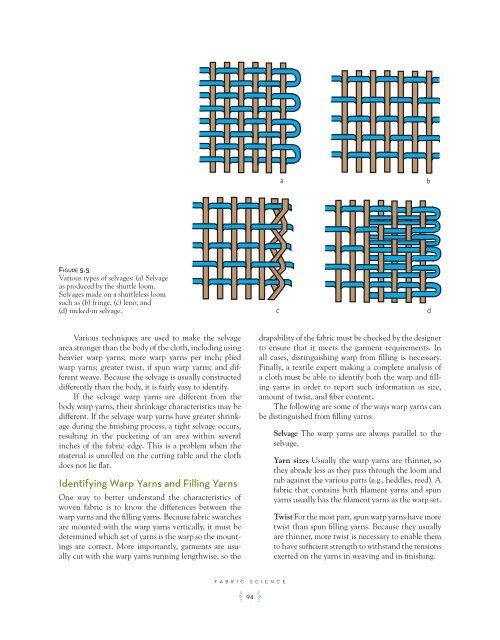You also want an ePaper? Increase the reach of your titles
YUMPU automatically turns print PDFs into web optimized ePapers that Google loves.
Figure 5.5<br />
Various types of selvages: (a) Selvage<br />
as produced by the shuttle loom.<br />
Selvages made on a shuttleless loom<br />
such as (b) fringe, (c) leno, and<br />
(d) tucked-in selvage. c d<br />
Various techniques are used to make the selvage<br />
area stronger than the body of the cloth, including using<br />
heavier warp yarns; more warp yarns per inch; plied<br />
warp yarns; greater twist, if spun warp yarns; and different<br />
weave. Because the selvage is usually constructed<br />
differently than the body, it is fairly easy to identify.<br />
If the selvage warp yarns are different from the<br />
body warp yarns, their shrinkage characteristics may be<br />
different. If the selvage warp yarns have greater shrinkage<br />
during the finishing process, a tight selvage occurs,<br />
resulting in the puckering of an area within several<br />
inches of the fabric edge. This is a problem when the<br />
material is unrolled on the cutting table and the cloth<br />
does not lie flat.<br />
Identifying Warp Yarns and Filling Yarns<br />
One way to better understand the characteristics of<br />
woven fabric is to know the differences between the<br />
warp yarns and the filling yarns. Because fabric swatches<br />
are mounted with the warp yarns vertically, it must be<br />
determined which set of yarns is the warp so the mountings<br />
are correct. More importantly, garments are usually<br />
cut with the warp yarns running lengthwise, so the<br />
FABRIC SCIENCE<br />
A 94 F<br />
a<br />
drapability of the fabric must be checked by the designer<br />
to ensure that it meets the garment requirements. In<br />
all cases, distinguishing warp from filling is necessary.<br />
Finally, a textile expert making a complete analysis of<br />
a cloth must be able to identify both the warp and filling<br />
yarns in order to report such information as size,<br />
amount of twist, and fiber content.<br />
The following are some of the ways warp yarns can<br />
be distinguished from filling yarns:<br />
Selvage The warp yarns are always parallel to the<br />
selvage.<br />
Yarn sizes Usually the warp yarns are thinner, so<br />
they abrade less as they pass through the loom and<br />
rub against the various parts (e.g., heddles, reed). A<br />
fabric that contains both filament yarns and spun<br />
yarns usually has the filament yarns as the warp set.<br />
Twist For the most part, spun warp yarns have more<br />
twist than spun filling yarns. Because they usually<br />
are thinner, more twist is necessary to enable them<br />
to have sufficient strength to withstand the tensions<br />
exerted on the yarns in weaving and in finishing.<br />
b













